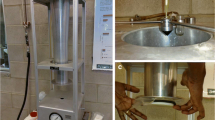Abstract
Tetramethrin, deltamethrin and Cypermethrin formulated as fumigant tablets or spray(ing) solutions showed flushing out activity on Triatoma infestans. Fumes arising from the tablets were analysed by gas chromatography. The proportion of pyrethroid liberated was between 10 and 20% of the original amount formulated. The flushing out activity shown was dependent on the pyrethroid compound, insect stage and sex. In general deltamethrin proved the most active flushing out agent and Cypermethrin the least active. Maximal activity was shown in the combination of nymphs and tetramethrin. Nymphs of Rhodnius prolixus were only flushed out by deltamethrin. In all cases, deltamethrin and Cypermethrin yielded 100% mortality 7 days after exposure to the pyrethroid fumes, while tetramethrin was not a killing agent.
Résumé
La tetraméthrine, la deltaméthrine et la cyperméthrine sont des pyréthrinoides que, formulées soit comme tablette fumigène ou comme solutions (spray), ont expurgé des insectes vecteurs de la maladie de Chagas cachés dans des refuges standards. La concentration des pyréthrinoides libérés des tablettes fumigènes, détecté par la Chromatographie gazeuse, a été 10 à 20% l’original. En plus, il a été observé que l’activité d’expurger les insectes (flushing out) produite par les tablettes fumigènes dépend de: type de pyréthrinoide, espèce d’insecte, stade de développement larvaire et sexe. Les résultats observés indiqueraient que la deltaméthrine a l’effet maximal de “flushing out” tandis que l’activité de la cyperméthrine a démontré être sensiblement inférieur. La tetraméthrine a été la plus active sur le 5 éme stade de Triatoma infestans. D’ail leurs, le 5 éme stade de Rhodnius prolixus a été seulement expurgé par la deltaméthrine. Dans tout les cas, la deltaméthrine et la cyperméthrine ont démontré produire un 100% de mortalité sept jours après l’exposition aux pyréthrinoides, autant que la tetraméthrine a été incapable de produire une sensible mortalité.
Similar content being viewed by others
References
Busvine, J. R. (1971) A Critical Review of the Techniques for Testing Insecticides Chapter XII, pp. 263–288. Commonwealth Agricultural Bureaux, London.
Busvine, J. R. and Barons, S. (1947) Observations and mortality among insects exposed to dry insecticidal films. Bull. Entomol. Res. 38, 81–83.
Casabé N., Melgar, F., Wood, E. J. and Zerba, E. N. (1988) Insecticidal activity of pyrethroids against Triatoma infestans. Insect. Sci. Applic. 9, 233–236.
Dias, J. C. and Silva, J. C. (1969) Sobre algunos aspectos da profilaxia defensiva en doenca de Chagas. Rev. Inst. Med. Trop. Sao Paulo 11, 236–244.
Paulini, E., Fomm, A. S. and Guedes, A. S., (1961) Ensaios sobre desalojantes no combate da doenca de Chagas. Rev. Bras. Malariol. e Doencas Trop. 13, 65–69.
Perlowagora-Szumlevicz, A. (1954) A eficiencia do expurgo domiciliano com hexaclorociclohexana no contrôle do vector da doenca de Chagas (a importancia da algumas caracteristicas dos triatomineos no planejamiento do ciclo de aplicacao do insecticida). Rev. Bras. Malariol. e Doencas Trop. 30, 57–63.
Picollo, M. I., Wood, E. J., Zerba, E. N., Licastro, S. A. de y Ruveda, M. A. (1976) Métodos de Laboratorio para medir toxicidad de insecticidas en Triatoma infestans (Klug). Acta Bioquim.Clinica Latinoameric. X(1), 67–70.
Pinchin, R., de Oliveira Filho, A. M. and Pereira, A. C. B. (1980) The flushing out activity of pyrethrum and synthetic pyrethroids on Pastrongylus megistus, a vector of Chagas disease. Trans. Roy. Soc. Trop. Med. Hyg. 74, 801–803.
Pinchin, R., Fanara, D. M., Castleton, C. W. and Oliveira Filho, A. M. (1981) Comparison of techniques for detection of domestic infestations with Triatoma infestans in Brazil. Trans. Roy. Soc. Trop. Med. Hyg. 75, 691–694.
Ruigt, G.S.F. (1985) Pyrethroids. InComprehensive Insect Physiology Biochemistry and Pharmacology, Vol. 12 Chapter 7, pp. 184–251, Pergamon Press.
Wisnivesky-Colli, C., Paulone, I., Perez, A., Chuit, R., Gualtieri, J., Solarz, N., Smith, A. and Segura, E. (1987) A new tool for continuous detection of the presence of triatomine bugs, vectors of Chagas’ disease, in rural households. Medicine (Bs.As.) 47, 45–50.
Zerba, E. N. (1989) Chemical control of Chagas’ Disease vectors. Biomed. Environ. Sci. 2, 24–29.
Zerba, E. N., Licastro, S. A. de, Wood, E. J. and Picollo de Villar, M. I. (1987) Insecticides: Mechanism of Action. In Chagas Disease Vectors (Edited by Brenner, R. and Stock, A.), CRC Press. Vol. III, Chapter 5, pp. 101–124.
Author information
Authors and Affiliations
Rights and permissions
About this article
Cite this article
Wood, E., De Licastro, S.A., Casabé, N. et al. Evaluation of the Flushing out Activity of Pyrethroids on Triatoma Infestans. Int J Trop Insect Sci 14, 651–655 (1993). https://doi.org/10.1017/S1742758400018075
Received:
Accepted:
Published:
Issue Date:
DOI: https://doi.org/10.1017/S1742758400018075




